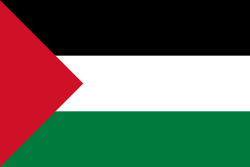阿拉伯復興社會黨—敘利亞地區
政党 来自维基百科,自由的百科全书
阿拉伯復興社會黨—敘利亞地區(阿拉伯語:حزب البعث العربي الاشتراكي – قطر سوريا,羅馬化:Ḥizb al-Ba'th al-'Arabī al-Ishtirākī – Quṭr Sūriyā),簡稱敘利亞復興黨,是敘利亞歷史上的一個政黨。1963年,該黨發動軍事政變,推翻原政府,建立敘利亞復興黨政權。1970年,哈菲茲·阿薩德發動「糾正運動」,奪取敘利亞政權和復興黨領導權。2000年,哈菲茲·阿薩德去世,其子巴沙爾·阿薩德接掌政權。2024年12月8日,敘利亞復興黨政權被敘利亞反對派推翻;12月11日,該黨正式宣布停止運作,事實上解散[1]。
阿拉伯復興社會黨—敘利亞地區 | |
|---|---|
| حزب البعث العربي الاشتراكي – قطر سوريا(阿拉伯語) | |
| 成立 | 1947年4月7日 |
| 解散 | 2024年12月11日(事實上)[1] 2025年1月29日(名義上) |
| 總部 | 大馬士革 |
| 黨報 | 《復興》 《革命》 |
| 意識形態 | 新復興主義
歷史上: |
| 國內組織 | 全國進步陣線 |
| 阿拉伯組織 | 阿拉伯復興社會黨(1947年—1966年) 阿拉伯復興社會黨 (敘利亞主導派)(1966年—2024年) |
| 口號 | 「統一、自由、社會主義」 「阿拉伯人萬歲」 |
| 黨旗 | |
 | |
| 官方網站 | |
| www | |
| 敘利亞政治 政黨 · 選舉 | |
背景
該黨的背景主要是由阿拉維派的軍方和民兵組成,並由阿薩德家族直接操縱和控制。該黨從1980年至2024年獲蘇聯(及其繼承者俄羅斯)、伊朗、朝鮮、中華人民共和國,以及黎巴嫩真主黨的支持及軍事援助。該黨強烈反對美國、英國和法國,不承認以色列為主權國家,並要求以色列歸還自1967年被其軍事佔領的戈蘭高地,作為和平談判相互承認的基礎。
歷史
該黨的前身可追溯自1940年代興於敘利亞小資產階級知識分子中的阿拉伯復興黨 (Arab Ba'th Party)。阿拉伯復興黨的創始人米歇爾·阿弗拉克和薩拉赫丁·比塔爾分別為希臘東正教教徒及遜尼派穆斯林[23],但因兩者均希望統一阿拉伯國家而開始以「阿拉伯復興運動」的名義進行具有政黨性質的政治活動[24]。1943年7月,阿弗拉克提出黨的口號為「統一的阿拉伯民族,具有不朽的使命[25]」。1947年4月,在大馬士革聯合召開第一屆民族代表大會,大會選舉阿弗拉克為黨主席,比塔爾為黨總書記,黨綱強調「阿拉伯祖國是政治經濟不可分割的整體」,復興黨正在領導「一個爭取阿拉伯統一、自由和社會主義的人民民族革命運動[25]。」該黨的主要支持者是大馬士革的伊斯蘭教遜尼派和基督教知識分子,也受大量遜尼派穆斯林主體外的少數族群支持,並在敘利亞北部阿拉維派和南部德魯茲人聚居地區設有分支[24]。1952年,與倡導革新封建土地所有制並反對外來侵略的阿拉伯社會黨合併[24]。1954年,復興黨成為敘利亞議會第二大黨,並且有兩個成員成為外交部長及經濟部長[26]。1955年,復興黨一位高級成員阿德南·馬爾基被敘利亞民族社會黨成員暗殺,復興黨便對敘利亞社會民族黨進行清洗。1958年2月1日,敘利亞與埃及兩國合併成立阿拉伯聯合共和國,解散復興黨等的所有敘利亞政黨[27]。1962年,在黎巴嫩召開會議,決定在敘利亞重建復興黨,並且建立臨時地區領導機構[28]。
1963年3月8日,下級軍官發動軍事政變,成功奪取國家政權,對復興黨政權的權力結構演變具有決定性的意義,標誌著年輕且激進的下級軍官成員在黨內的興起。1966年,薩拉赫·賈迪德及哈菲茲·阿薩德發動政變,奪取復興黨民族領導機構和地區領導機構領導權。1967年第三次中東戰爭後,新復興黨人逐漸產生了以賈迪德為首的激進派和以阿薩德為首的務實軍人派的兩個派別,並且在對內對外政策主張等方面發生嚴重分歧,甚至出現了以民族領導機構和以地區領導機構為背景的兩個權力中心[29]。1970年11月13日,阿薩德發動不流血軍事政變,並被其描述成「響應我國人民的要求和願望」而發動的「糾正運動」。從此開啓了敘利亞阿薩德時代,直至2000年6月阿薩德去世[25]。
受到阿拉伯之春的影響,敘利亞反對派於2011年1月26日開始,組織民眾和平示威,要求敘利亞政府實行政治改革、恢復公民權利,以及結束自1963年以來實行的國家緊急狀態。巴沙爾·阿薩德於2011年1月31日接受《華爾街日報》採訪時,表示自己需要作出改變以適應民眾不斷崛起的政治訴求和經濟需要[30][31]。根據巴沙爾的改革承諾,當局於4月21日廢除了緊急狀態法,並在8月4日由巴沙爾簽署了允許各派別建立合法政黨的政黨法法令。
與此同時,受西方支持的敘利亞國外反對派以及變節的政府軍士兵分別組建了自由敘利亞軍以及敘利亞全國委員會,同時基地組織也潛入敘利亞,並與反政府武裝建立了聯繫,敘利亞由此正式進入內戰。2024年12月阿薩德政權被反對派武裝推翻。
從大體上講,敘利亞政府主要受到來自俄羅斯與伊朗的軍事援助,而敘利亞反對派則受到大部分西方國家、海灣六國以及由穆斯林兄弟會掌權的遜尼派阿拉伯國家的武器和資金援助。分析認為,一旦阿薩德家族為首的復興黨政權倒台,激進遜尼派掌權,伊朗必然會首當其衝,成為其他遜尼派阿拉伯國家和西方的重要打擊對象。
12月8日,首都大馬士革被攻陷,總統巴沙爾·阿薩德乘飛機流亡至俄羅斯[32][33][34],結束該黨在敘利亞61年的統治。該黨亦於12月11日宣告終止運作。2025年1月29日,在敘利亞革命勝利宣告會議上,該政黨連同復興黨政權的其他組織一起被正式解散並被禁止。
參見
參考文獻
Wikiwand - on
Seamless Wikipedia browsing. On steroids.
